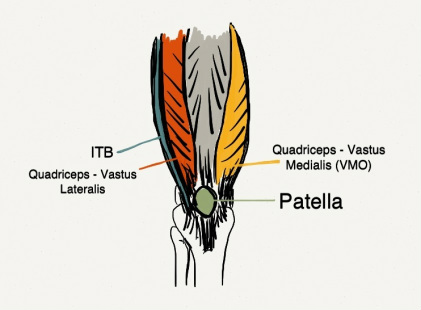 FIG. A: Patellofemoral Pain Syndrome & the Anatomy of the Knee (Frontal View). Copyright Jennifer Lamb Massage.
FIG. A: Patellofemoral Pain Syndrome & the Anatomy of the Knee (Frontal View). Copyright Jennifer Lamb Massage. Also known as: Runner's Knee; Patella Tracking Syndrome; Patellar Subluxation; ITB Syndrome
What is it?
What causes it?
What is the treatment protocol?
In the medium-term, exercises that specifically address the imbalance of tension around the patella will help to correct the position of this bone as the knee moves. Specifically, exercises that strengthen the VMO, as well as stretching the Quadriceps muscles in general, will assist in creating better muscle balance around the patella itself. Using a Foam Roller to release tension in both the ITB and Vastus Lateralis will help to reduce the lateral pull on the patella. Additionally, regular Hamstring stretches may help reduce the medial Hamstring tension that typically develops as a result of this muscular imbalance.
In the long-term, however, the biomechanical problems that have led to the muscle imbalance around the affected knee must be addressed in order to overcome this injury. Commonly, PFPS is associated with weakness in the Gluteus Maximus - the large muscle of the buttocks that ideally provides the main propulsion forward during a walking or running gait - as well as weakness in the Gluteus Medius - a smaller, deeper and slightly more lateral buttock muscle that is important for pelvic and hip stability. When these muscles are weak or firing out-of-sequence during a run or walk, the Quadriceps muscle will typically become overactive to compensate for this weakness, providing the propulsive movement forward instead of the Gluteal muscles. By strengthening these Gluteal muscles, the hips will be more stable and the Quadriceps will be less likely to be over-used for forward propulsion. Thus, the strain on the patella and knee is reduced. Additionally, addressing any foot biomechanical problems, such as pronating (dropping) arches, by appropriate lower leg and arch strengthening exercises, or by wearing corrective orthotics, will help to create a more efficient and stable gait, with less torsion at the knee.
How can Remedial Massage help?
For more information...
- "Patellofemoral Pain Syndrome" on the MyDr Website: basic information about this injury.
- "Patellofemoral Pain Syndrome" on the PhysioAdvisor Website: more detailed information about this injury.
- "Patellofemoral Pain Syndrome" on the Sydney Sports Medicine Centre Website: includes some exercises to help treat & avoid this injury.
- "The Best Treatment for Patellofemoral Pain Syndrome" YouTube clip by Lisa Howell of Perfect Form Physio: great explanation of how PFPS is not simply a knee problem, but must include treatment of the underlying factors that are likely causing the muscular imbalance around the knee in the first place.
- "Pilates Foam Roller - Myofascial release of outer thighs/ITB." YouTube video by Martina & Gemma of Perth-based Sense of Space Pilates Studio: demonstrates 3 alternative positions for releasing the ITB using a foam roller.
- "Pilates body - The Clam Exercise." YouTube video by Wayne Gordon of Sports Injury Clinic: demonstrates the basics of how to do the "Clam" exercise for strengthening the Gluteus Medius muscle.
 RSS Feed
RSS Feed
